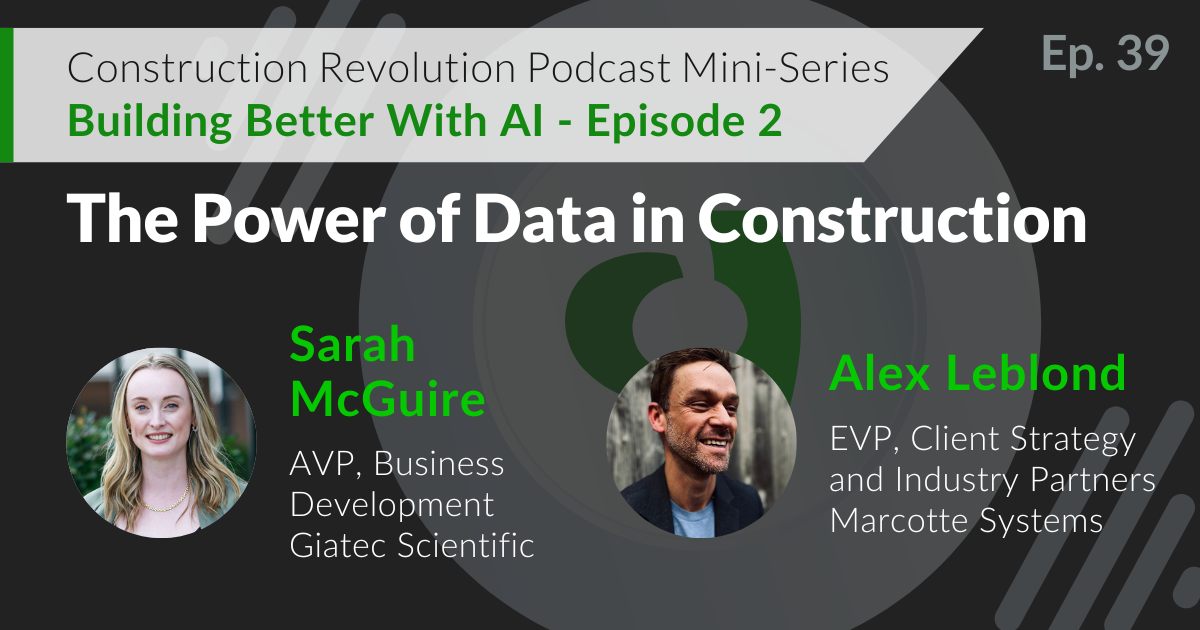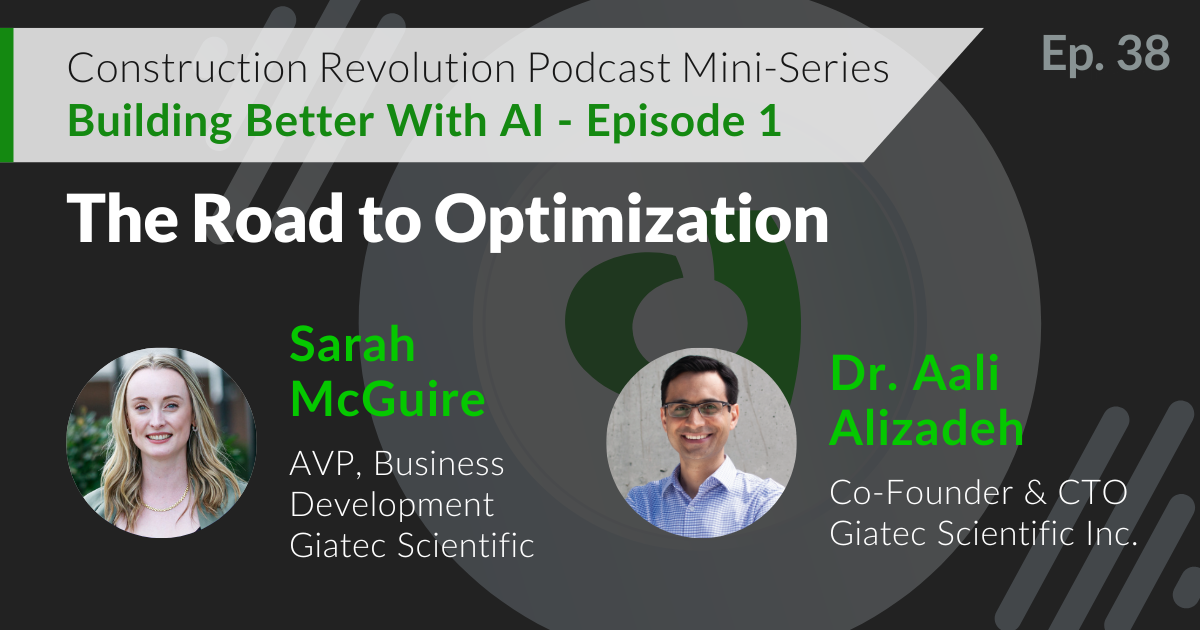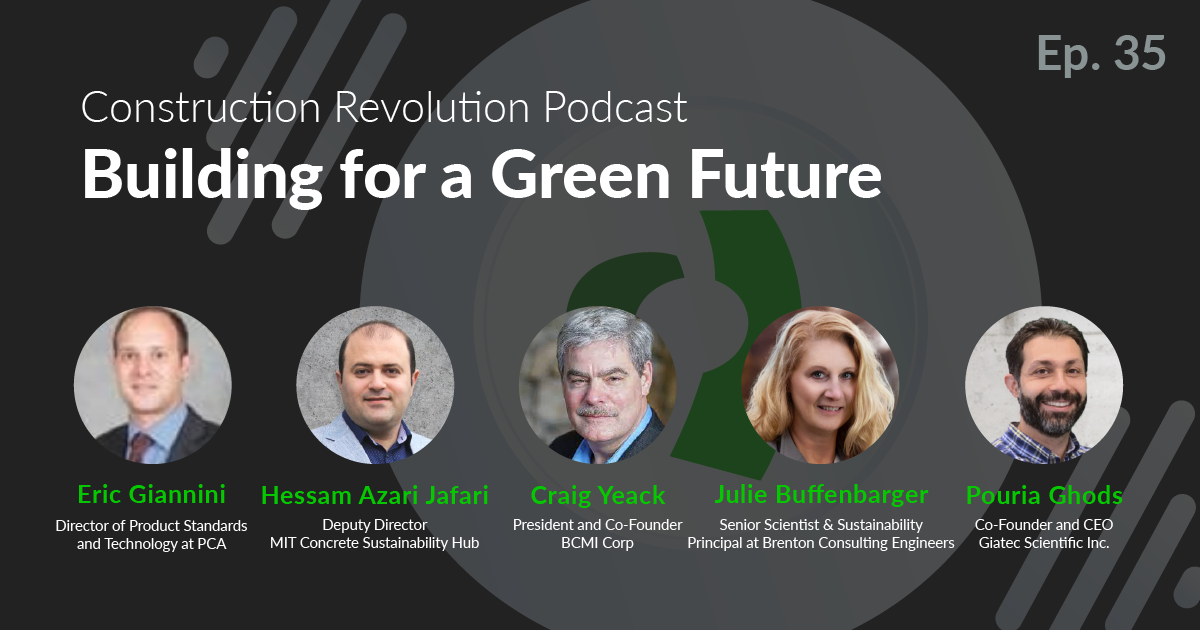
Episode 6 |
April 13, 2021
Getting to Net Zero
In This Episode
In this episode hear from sustainability expert Dr. Phil De Luna, Director of Materials for Clean Fuels Challenge Program at the National Research Council Canada about the technologies and practices that are being implemented today to get to net zero and reduce CO2 emissions. Find out what capturing carbon is, the role that diversity plays in leadership, the impact of effective communication, and more.

Host
ERIC YEE
Content Marketing Manager, Giatec Scientific Inc.

Guest
Dr. PHIL DE LUNA
Director, Materials for Clean Fuels Challenge Program, National Research Council Canada.
Podcast Transcript
Eric:
Phil, your work puts you at the cutting edge of a lot of exciting technology developments. What new technology are you most excited about that can have a direct impact on the construction industry?
Phil:
Yeah, there are so many interesting technologies right now. And maybe I’ll give a step back and I like to give Phil’s five point plan to get to net zero. Step one, is to conserve what we have, so whether that’s natural habitats, lived environments, the Amazon Rainforest, let’s protect the land that we have and let’s try not to clear cut forest to ranch more, basically. Number two, is to increase renewable energy as much as possible everywhere. And so that’s wind and solar, hydroelectricity, non-emitting fossil fuel sources of energy, which are in fact, wind and solar for example, are now cheaper than coal. So that’s well on its way and it just needs to be implemented and scaled out a little bit more rapidly. Step three, is to electrify everything, everything we possibly can. And in the building side of things, you can think of heat pumps and electrification of, as much of the inefficiency as LED lighting, et cetera. Electrify with these clean green renewables, as much as possible.
And a big piece of that, is electric vehicles and transportation. Electric vehicles are booming right now and there are so many new models coming on this year, which is really exciting because it’s becoming more and more accessible to the consumer. So what Canada needs to do is start building the infrastructure for that. And I would not be surprised if you start seeing electric vehicle charging stations being requested in build homes or in large condo builds, for example, as well, and big garages. So thinking about that is also, how to prepare yourself for that transition to an electrified transportation grid. And then step four, is to address the hard to abate sectors. Now, these are sectors that you cannot electrify or are very difficult to electrify and where the majority of emissions where you would expect from the construction industry come from. Making steel, making cement, fertilizer, process emissions.
And in these situations, we have to look at other forms of fuels or feedstocks that don’t emit CO2. And one of the ones I’m really excited about, for example, and everyone is giving a lot of hype on, is hydrogen. And so I’ll talk about that in just a moment. And the last, step five, is to capture carbon from the atmosphere. We got into this mess by taking fossil fuels out of the ground, extracting energy from it and releasing carbon into the air. We have to take the carbon out of the air and put it back underground. We can’t out efficient our way out of this mess, and we can’t plant enough trees fast enough to get us down to net zero, so we really need to think about artificial ways to take CO2 out of the air. In the construction industry, one of the things that is really interesting to me, is building materials that have embedded carbon in them or building materials that are produced in a low carbon way.
And I’ll give two examples, the first is steel that is being produced using hydrogen or electric arc furnaces or other forms of reduction of that steel that don’t have to rely necessarily on natural gas or on fossil fuel emission. Of course, much of the steel that’s made today are based on equipment that is already sunk cost and has to be amortized over many years and they will be online for much time. So the second thing that we need to think about, is retrofitting those existing assets, whether it’s cement plants or steel plants, with carbon capture. And that’s the second piece, that’s the second technology, whether it’s carbon capture and even then, taking that CO2 and then embedding that into our concrete and into our cement.
Because when you do that, the CO2 actually hardens into a carbonate, a solid, and therefore can actually help to strengthen, or at least replace some of the emissions that you would have from cement. So in the construction industry, there’s so much happening right now, also on digitization, on artificial intelligence, and machine learning, and inefficiency. But when we really want to tackle big emissions, we have to think about the life cycle of the materials that are being used in the construction industry, and how do we decarbonize the production of those materials?
Eric:
Sounds like we have our work cut out for us. I had a quick question on, when you said, part of Phil’s five point plan, capturing carbon that’s already released into the atmosphere, how do we do that? What technologies are out there that would enable us to do that?
Phil:
Yeah, well, there’s a few of these technologies that are all being pioneered by SMEs, small medium enterprises, these startups. Canada is actually one of the world leaders in this, there’s a company called Carbon Engineering, and basically what they do is they have these massive fans that suck in air, or that will blow air in. And these big air contactors that actually were designed and implemented through HVAC systems. So they took a technology that existed and then they changed it or modified it to allow it to capture CO2. So they have these big air contactors that they then allow and drip a carbon capture solution, a caustic KOH, such that CO2 actually gets captured in that solution and turns into a carbonate. And then now they have that capture in the solution and they can move it out of the air.
So Carbon Engineering is a wonderful example of a company that has gained a lot of traction recently, that’s based out of Squamish in British Columbia. And one of their first commercial plants is with Occidental, an oil and gas company, that it is being used for enhanced oil recovery. Essentially, they’re taking the carbon dioxide from the air, and then they’re pumping it back underground to help retrieve some of hardest to get oil that’s underground.
And you may be thinking, “Well, you’re capturing CO2 to get oil, so that seems counterproductive.” But if you can actually sequester more CO2 underground, then the oil that you remove from it, it ends up being a negative benefit. A lot of work has to be done to understand what the science, and the regulation, and the monitoring of that is underground because this is such a new field and there are only very few storage locations in the world that can actually take CO2 and store it underground. But this is one of the areas where capturing CO2, storing it underground, or using it in construction materials, and fuels, and chemicals, I think that’s going to be a massive, massive opportunity in the future.
Eric:
Thanks, Phil. That’s, I think, really interesting, it’s such an interesting time to see all of these advancements and how rapidly they’re coming on. Where I feel like maybe 20, 30 years ago, it was a bit slower pace in this advancement in technology on all fronts. But now it seems like the world’s mobilizing to fix these issues that we’re facing.
Phil:
Yeah, I think that’s a wonderful point, and to that point, around 20 or 30 years ago, a lot of the technologies or unclean technologies were academic in nature. Or they were looking at them as alternatives to fossil fuels because people were worried about fossil fuel scarcity, that we would run out. But then fracking was invented and then the Permian Basin in Texas, and the Shell gas revolution, and it became very quickly that within five or six years, United States became a net energy importer to a net energy exporter. And all around the world, technologies and advancements of being able to extract oil and gas, and find oil and gas, made it clear that we would not be running out anytime soon.
But today the drive is not because of fossil fuel scarcity, but rather because of climate change. And that drive is becoming more and more urgent, especially as younger and younger people become more and more passionate and driven to understand and try to solve that problem. Because younger generations, more and more younger generations will be the ones who bear the brunt of the worst effects of climate change, especially as time goes on. Climate change is a lagging effect, similar to how deaths are a lagging effect in COVID-19. It takes a couple of weeks for those deaths to catch up to the initial infections. It takes a few decades for the impacts of climate change to catch up to when they were first admitted. So, we really have to think about this as a long-term shock, whereas boiling the frog analogy, whereas COVID-19 is the ultimate short-term shock.
Eric:
Yeah, it’s definitely hard to get people to mobilize when they don’t see those immediate effects, those cause and effects. So you touched on something interesting with the younger generation coming in. So, I’m wondering now, there’s a lot of exciting advancements that can, especially on the constructions industry, impact things, but one key factor that determines how things change, is the adoption of those new practices and things like that. So what role do you think diversity plays in this conversation, particularly on a leadership level?
Phil:
Yeah, that’s a wonderful question, and I think what I’ll do actually maybe is give the context of Canada, the United States, really North America. And why would you think about diversity, not only because it’s a socially right thing to do, but also for a social cohesion, a polarization perspective and economic growth perspective? In North America and in many developing worlds, our birth rate is below repopulation, meaning it’s below two or 2.1. We no longer have enough kids to maintain the population of our countries. In order for us to continue to grow, in terms of our economy, in terms of being able to have a workforce that can support our older generations, especially with our baby boomers entering the retirement age and soon they will be out of the workforce and the brunt of economic growth will be on younger generations.
The answer to this is we need to have more immigration. We need to have more immigration in order to increase our population, in order to build our economies, in order to grow. And America and Canada have always been countries of immigrants, whether they were Irish Catholics from Ireland or whether they were Ukrainians, and Germans, and Russians at the turn of the 20th century, to Southeast Asians, and people from Africa, and the Caribbean today. We have always been a country of immigrants. The problem that I see, is if we do not create more diversity, especially in leadership positions, especially in positions where decisions are made, then these decisions are being made by a small slice of a demographic, but it’s not representative of the rest of the country. And moreover, they may not have the same perspective as other Canadians, whether that is from a racial standpoint, a gender standpoint, a sexual orientation standpoint.
It’s always, in my view, better to have diverse opinions, and this has been proven as well, McKinsey did a study that showed diverse management teams are 36% more profitable than non-diverse management teams. The reason being, is that you just have more brain power and you just are able to tackle problems in a more efficient and thorough way. So when it comes to tackling climate change, when it comes to the leadership of tomorrow in the construction industry, or in any industry, we really have to understand that what Canada will look like, what the world will look like tomorrow will be much more diverse. And the problems that face us, face us all. Carbon dioxide does not know borders. CO2 that is admitted in Canada, the impacts of that CO2 will be felt in China and vice versa, or in India or in the Middle East or wherever.
So we have to come together, we have to understand that diversity is a strength, which I think North America, Canada, America has known this for generations. And then we have to utilize our people in ways that fully appreciate their skills and perspectives so that we can come up with more robust solutions. And we can come up with solutions that work for everybody, because if we don’t, the consequence is a more polarized world, a world of haves and have nots, and quite frankly, a world of political discourse that will lead to more stagnation and less focus on the problem.
Eric:
Yeah, I think there were some great points, especially, well, all of it are great points, Phil. But, when you touched on even how businesses can be more profitable, from that standpoint, it’s like the profitability standpoint of a business. If you have everyone in the same room that has the same background, same education, they’re going to be very good at that one narrow focus, but they’ll have blinders to the rest of the world or different approaches to things that you need to inject those things into your business. And even into our country and our government in order to thrive and to be able to see those opportunities that otherwise we’d just be blind to.
Phil:
Exactly. Couldn’t agree with you more.
Eric:
So I also know that you’re passionate about science communication, this is something that I have been very interested in, especially over the past year and a half. So throughout 2020 with everything going on, I’m sure you and I have both seen a wide arrange of effective, but also ineffective communications on science finds and recommendations from different levels and different organizations. So when you’re communicating something complex to the public, how do you do so in a way that people actually understand your message?
Phil:
I think that there’s a stereotype that scientists don’t know how to communicate. And I would say that, that was probably true a few decades ago or a few years ago, but today science, just like the world, has really evolved in a sense that I believe, before, people really worked in the silos. They studied one thing, they knew that one thing. We were talking before the podcast, both of our fathers worked in the automotive sector, the idea of working in an automotive plant, getting a pension, working there for 40 years, that idea is over. The world of today is much more dynamic, people will change careers often, and that’s a good thing. So I think that scientists today, just like the rest of the world, have really become much more well-rounded because the times are requesting it, the times demand it.
So when I look at effective science communication, the number one thing that’s the most effective, whether it’s science communication or any other communication, is a strong sense of empathy, of being able to understand who your audience is and put yourself in their shoes. Oftentimes, the problems that I see with science communication, is they do one of two things, they either speak too high, or they speak too low. Meaning, they either speak too technically to an audience that is not technical, or they dumb things down to an audience that knows what they’re talking about.
And on one hand, actually on both ways, they can either seem disinfected and out of touch, or they can seem arrogant. So what is really important in science communication, effective science communication, is to keep things simple, but also be respectful and understand, don’t dumb things down, simplify. And to be as empathetic as possible to the audience that you’re speaking to, to try and slow your speech, or to try and illustrate your points with stories and examples from the real world and analogies that other people may understand. Because everyone can understand it, the issue with science is that there’s a lexicon, there’s a language. And so when I talk about science communication, it’s really more about translating that lexicon, translating that language, to what other people can understand.
Eric:
That makes a lot of sense, especially just, I always like speaking with analogies or stories, because I find that those things get remembered more and they can tie into someone’s brain a little bit more. That they can reference something and then think back to what the context was around it.
Phil:
Mm-hmm (affirmative). I’ve always said that people will never remember what you say, they’ll remember how you made them feel. And again, it really boils down to that sense of empathy, that sense of emotional intelligence, which I think a lot of people under appreciated, especially scientists. Scientists are very quantitative, they’re very data-driven. And you have to tap into a side of yourself that appeals to emotion, that appeals to feeling, that appeals to things that are more diffused. And that’s how you communicate with people, and that’s how you get your science across.
Eric:
So in terms of getting things across and trying to really get your message to be understood and driven home. I know one thing that I’ve seen in past organizations, but also maybe in the wider construction industry, is adoption of new technologies or even sustainable practices. It can be hard to communicate that to upper management or to other people in the organization. So what would you recommend to someone who’s maybe interested in these areas, but don’t know how to communicate it internally in order to win people over to their idea?
Phil:
That’s a great question, and this is something that I have to do a lot for my work is, communicate above and below the organization, to influence whether that’s soft or hard to my bosses and then to the people who report to me. And in both situations, it’s really about convincing them and trying to come prepared with facts and building the case. So if you wanted to implement a new clean technology, you need to do your homework and understand what this clean technology means and what its implications are for your business, for your construction operations, for whatever it is. The thing that I’ve come to realize about clean technology, is everyone loves it until they have to pay for it. So one of the things that a lot of people are realizing, is that the role the government has to play, is to de-risk technologies in order to have confidence for the private sector to then implement those technologies in their operations, in their field.
So I would say, when you want to bring a new technology or a new idea to your management, the number one thing is to understand where is that technology or idea in its development? Is it a low technology readiness level, where it’s just in the lab? Or is it a high technology readiness level, where you can purchase it off the shelf and implement it right away? Or it’s something in between? And you have to understand what the risk associated and the cost associated is, from developing something that is a little bit more fundamental and implementing that to something that’s ready to go in commercial. Understanding that risk that is involved with that, gives you a better, again, an empathetic view of what your manager is feeling. Because you have targets, you have revenues you have to hit, you have projects you have to deliver on.
The last thing that you want to do is delay that, or put that at risk. So understand the technology and what the risk associated with it is. And then second, understand what the benefits are. It’s great if the technology can save time, it’s great if the technology can lower emissions, but it’s even better if the technology can save money. That’s very rare, those three things in combination. So then, if you can find two or one of those things, look for other ways to partner or to de-risk those other pieces, I’ll give you an example.
There are lots of programs run by the government, by federal provincial municipal governments that provide tax credits for research and development, or provide public private partnership funding to implement new clean technologies. Look for those opportunities, and then build that business case to say, “Okay, this is going to cost this much, but we can cost share it with the federal government for this. And the impact will be this, and our OPEX savings will be this, and our carbon emissions savings will be this.” So it’s obviously a lot of work, but I think you’ll find that when you get excited about a new technology and you start diving into it, it’ll also make you a more critical thinker and understand what technology is real, what technology still needs more developing, and what technology is the right fit for you and your business.
Eric:
Thank you for that Phil, that’s actually a fantastic answer. I think when you were talking about knowing technology inside and out, as well as how you can, de-risk it, and how to put it into context, that’s going to make it a slam dunk or an easy decision for those that are making those decisions. That’s something that I have had to learn over a long time because I’ve pitched things too prematurely in the past and they have not gone over well, so thank you for that lesson Phil.
Phil:
At the same time, pitching things and it not going well is a lesson in and of itself. So I would say, you never really know, don’t let perfection be the enemy of good. You may be looking into something and you’re like, “Oh, I need to look into it more. I need it before I build a case.” The thing is, clean technology business life just moves so quickly that if you don’t capitalize an opportunity, or if you don’t put yourself out there, then you may not get a shot. So I would say, yes, do your homework, try to understand, but even if it’s premature, say that up front when you pitch it. Say, “Hey, you know what? This is an early idea. I’m not sure if it really has legs, but it’s an exciting thing. Is this something that you would be interested in, if I did more homework and tried to understand it more, and tried to build a case for it?”
So, what you’re doing by doing that is, you’re making your management a part of that decision-making process. You’re bringing them along the journey and you’re subtly influencing them to think that it’s their idea as well. Because now they’ve become invested and they want to know more. So rather than going to your management and say, “This is a thing, I want to do this, let’s go do it, this is what’s right.” Be, “This is something that’s really interesting. This could be something that could really help this organization. This could really help cut costs. This could really help put down CO2, but I need more time to understand, what do you think? Have you seen anything like this before? Should we dive into this a little bit deeper? Can I come back to you in a week with more data?” And then that way you’re building your case collaboratively, which really goes a long way to just coming with something that’s fully baked and then hoping for the best result.
Eric:
I like the idea of getting everyone on board and having them part of the decision making and having more ownership in the idea, that’s fantastic Phil. So Phil, I just want to say thank you so much for coming on the show today, but before I let you go, I just wanted to let everyone in the audience know about your podcast and some of the work that you do, maybe you could talk a little bit about that.
Phil:
Sure, yeah. So I have a new podcast, I actually started it with a friend of mine over the holiday break because it’s a pandemic and what else can we do? We release episodes weekly on Mondays. It’s called What’s Next In, and it’s a podcast about the rapidly changing world and how we can get ahead of it. It’s a conversational podcast between me and my cohost, and we talk about a range of topics such as, what’s in an introduction? What’s next in social media? What’s next in carbon taxes? Technology for the aging population? What does happiness mean in the 21st century? And how can we promote diversity inclusion in organizations? How can we promote entrepreneurship rather than entrepreneurship, which is really about making change from within a large organization? So it’s a podcast about anything and everything, but we always talk about what we think is coming ahead in this field, and why we should be thinking about it, and how we can prepare ourselves.
Eric:
Awesome. Thank you so much Phil, so check out What’s Next In, and I’m sure it’s available everywhere, Phil?
Phil:
Yep, it’s on Spotify, Apple Podcasts, Google Podcasts, Anchor, and you can always go to www.whatsnextin.com to see the new episodes every week.
Eric:
Awesome. Thank you so much again, Phil.
Phil:
Thank you.
Other Related Episodes
Episode 39 |
April 4, 2024
The Power of Data in Construction
In the second episode of our “Building Better with AI” mini-series, host Sarah McGuire explores “The Power of Data in Construction” with Alex Leblond, EVP Client Strategy and Industry Partners of Marcotte. Join Sarah and Alex as they delve into the dynamic world of construction data, unravelling the complexities of on-premises systems and shedding light on the industry’s journey toward technological advancement. Gain valuable insights into the challenges of acquiring and processing data and discover how innovative solutions are reshaping traditional practices. Guided by Alex’s extensive experience at Marcotte, this episode offers a comprehensive exploration of the past, present, and future of data in construction. From discussing the evolution of batching systems to the transformative potential of AI, this conversation delves into the pivotal role of data in driving efficiency, sustainability, and profitability. Don’t miss this enlightening episode as we continue our mission to build better with AI!
PLAY
Episode 38 |
March 21, 2024
In this thrilling debut episode of our “Building Better with AI” mini-series, dive into the dynamic world of concrete innovation with the visionary Co-Founder and CTO of Giatec, Aali Alizadeh, Ph.D. Dr. Alizadeh shares captivating insights into the challenges facing the concrete industry and how Giatec® SmartMix™ offers transformative solutions. From tackling overdesign to breaking down data silos, discover how SmartMix is reshaping concrete management practices with its cutting-edge AI technology. Join host Sarah McGuire as she delves into the narrative behind SmartMix’s groundbreaking journey, uncovering its revolutionary impact on concrete mix management and optimization. This is just the beginning! Stay tuned for exciting insights into the future of construction as we tease upcoming episodes that promise to push the boundaries of innovation even further. Listen in now and join us as we embark on a thrilling journey to build better with AI! Ready to unlock your concrete advantage? Learn more about SmartMix.
PLAY
Episode 35 |
January 2, 2024
In this episode of The Construction Revolution Podcast, you’ll hear from construction industry experts as they explore the future of green construction and share their vision for a more sustainable built environment. This panel discussion was originally recorded in March 2023, at the Net Zero Construction Conference. To hear more insightful conversations like this one, don’t miss the 2024 Net Zero Construction Conference. Stay up to date with announcements about the conference by following the Net Zero Construction Conference on LinkedIn or by signing up for the newsletter on the Net Zero Construction Conference website.
PLAY
Want to Be a Guest Speaker, Sponsor, or Just Have a Question for Us? Fill In the Form!




